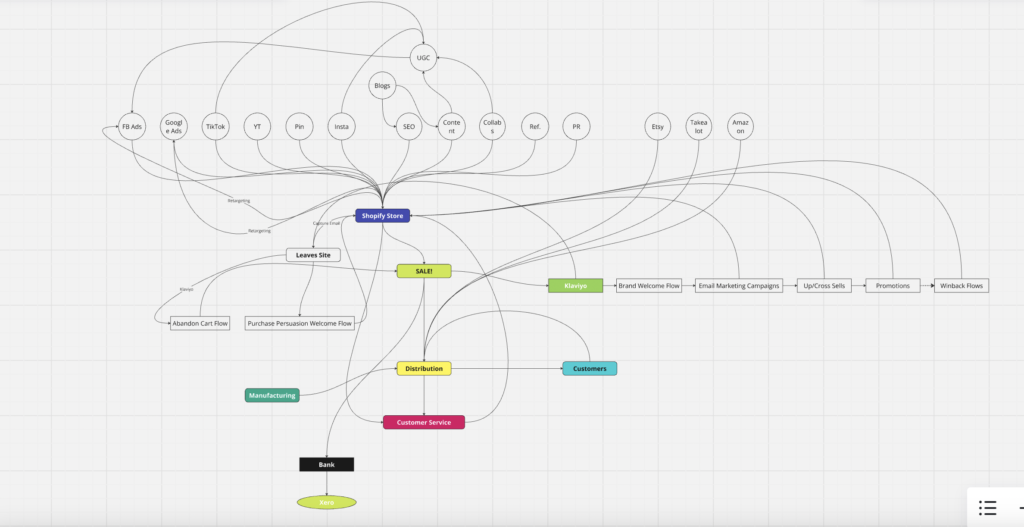In today’s competitive digital landscape, setting up a seamless e-commerce funnel is essential for success. Each step in the funnel serves a crucial purpose in guiding potential customers from discovery to purchase, and even re-engaging them after their initial transaction. This post will take you through the entire process by analyzing a robust e-commerce ecosystem map and breaking down each component of the journey. Let’s dive in!

1. Traffic Generation: Feeding the Funnel
The first step of any e-commerce strategy is to drive traffic to your store. But, not all traffic is created equal. A well-rounded approach uses a variety of platforms to bring in potential customers from all over the web. Key channels include:
- Facebook Ads: Targeted ads that let you reach specific audiences based on demographics, behaviors, and interests.
- Google Ads: Paid search results that help potential customers find your products when they’re searching for solutions.
- TikTok & Instagram: Social media platforms perfect for visual products, especially when leveraging organic content alongside paid ads.
- SEO: Driving organic traffic by optimizing your site for search engines and ranking for relevant keywords.
- Blogs & UGC (User Generated Content): Content marketing strategies that engage customers and encourage them to create content around your brand.
- Collaborations, PR, Referrals: Building relationships with influencers, media, and loyal customers to expand your reach further.
These channels work in tandem to generate traffic and funnel customers into your Shopify Store, the heart of your e-commerce ecosystem.
2. Shopify Store: Where the Magic Happens
Once potential customers are directed to your Shopify store, your goal is to convert visitors into buyers. But not every visitor will immediately make a purchase.
Here’s how your store should handle different scenarios:
- Conversion (Sale!): When a customer makes a purchase, they should be immediately added to your email marketing system (e.g., Klaviyo), where they can enter welcome flows, post-purchase upsell campaigns, and more.
- Leaves Without Buying: Visitors who leave without making a purchase shouldn’t be forgotten. Retargeting ads (via Facebook, Google, TikTok) and email flows like the Abandoned Cart Flow can gently nudge them back to complete their purchase.
Retargeting and Remarketing
When someone browses your site but doesn’t make a purchase, retargeting campaigns can remind them of what they left behind. These campaigns are particularly effective when using personalized ads or discounts. Retargeting on platforms like Facebook and Google ensures your products stay top of mind even after a visitor leaves your store.
3. Email Marketing Flows: Nurturing Relationships
Email marketing is your secret weapon for building long-term relationships with customers. Whether it’s welcoming new customers or reminding them of abandoned carts, your email strategy can significantly impact your sales over time.
Key Email Flows:
- Abandoned Cart Flow: If a customer adds products to their cart but leaves without buying, this automated flow can bring them back with a reminder, often including a discount or free shipping offer.
- Purchase Persuasion Welcome Flow: After a customer purchases, a welcome flow solidifies their decision to buy and introduces them to your brand. It also primes them for future purchases.
- Brand Welcome Flow: This flow is designed to educate and excite new subscribers or first-time buyers about your brand’s story and values, creating an emotional connection.
In addition to these flows, ongoing Email Campaigns keep customers engaged with promotions, new product launches, or brand updates.
4. Post-Purchase Strategy: The Sale Doesn’t End at Checkout
After a sale, the journey continues. Distribution ensures your products are delivered in a timely and efficient manner, while Customer Service handles any queries or concerns that may arise. It’s essential to provide an excellent post-purchase experience, as this will influence whether or not a customer returns to buy again.
Increase Customer Lifetime Value (CLV):
After a customer makes their first purchase, there are multiple ways to increase their lifetime value (CLV). You can offer Up-sell/Cross-sell opportunities, special promotions, or run Win-back Campaigns to re-engage customers who haven’t made a purchase in a while. This ensures that even after the initial sale, the customer remains connected with your brand and continues shopping with you.
5. Operational Infrastructure: Backend Support
Your e-commerce store’s success is not just about front-facing customer interactions. The backend infrastructure plays a vital role in keeping things running smoothly.
- Manufacturing: Producing or sourcing high-quality products is key to satisfying customers and keeping them coming back.
- Banking & Xero: Financial management tools like Xero help track sales, expenses, and inventory, ensuring you stay profitable and efficient as you grow.
6. Data-Driven Growth: Measure and Optimise
The beauty of running an e-commerce business is the ability to track everything. Using analytics from Shopify, Facebook Ads, Google Ads, and Klaviyo, you can constantly optimize your funnel. This data allows you to identify what works, what doesn’t, and what changes you need to make to improve conversion rates, retention rates, and customer satisfaction.
Conclusion: Building a Sustainable E-commerce Ecosystem
The diagram we analysed lays out an intricate but highly effective system for running a successful e-commerce business. By driving traffic from various platforms, optimizing the Shopify store experience, nurturing relationships through email marketing, and providing stellar post-purchase service, you can build a business that not only attracts customers but also retains them.
The journey doesn’t end with a single sale—it’s about creating a cycle where customers keep coming back, and your ecosystem grows stronger with every touchpoint. This kind of attention to detail, planning, and execution is the secret to scaling your e-commerce business sustainably.